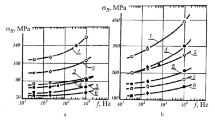Abstract
The effects of elevated temperature and high strain rate on fatigue life and tensile properties were measured for annealed 316 stainless steel and titanium alloy 6Al−2Mo−4Zr−2Sn in the solution-heat-treated and aged condition. A 14-KHz magnetostriction oscillator was used for fatigue testing. This equipment was developed for operation in excess of 2000° F. A split Hopkinson pressure bar provided dynamic tensile data up to 1300° F at strain rates on the order of 103 in./in./sec. An attempt was made to correlate the high-frequency-fatigue data with the dynamic tensile measurements by using the Manson fatiguelife-prediction methods. This paper contains the experimental results and discusses the analysis of these experiments.
Similar content being viewed by others
References
Manson, S. S., “Design Considerations for Long Life at Elevated Temperatures,” James Clayton Lecture, NASA Lewis TP. I-63. Presented at the Joint Internatl. Conf. on Creep Sponsored by Inst. of Mech. Engrs., ASTM and ASME, London, England (1963).
Thiruvengadam, A., “High Frequency Fatigue of Metals and their Cavitation Damage Resistance,” Hydronautics, Inc. Technical Report 233-6 (Dec. 1964). [See also Trans. ASME, Journal of Engineering for Industry (Aug. 1966)].
Thiruvengadam, A. and Preiser, H. S., “Cavitation Damage in Liquid Metals,” Hydronautics, Inc. Technical Report 467-Final, NASA CR-72035 (Nov. 1965).
Morrow, J. D., “An Investigation of Plastic Strain Energy as a Criterion for Finite Fatigue Life,” The Garrett Corp. Report, Phoenix, Arizona (1960).
Tavernelli, J. F. and Coffin, L. F., “Experimental Support for Generalized Equation Prediction Low Cycle Fatigue,” Jnl. Basic Eng.,84 (4) (Dec. 1962).
Valluri, S. R., “A Unified Engineering Theory of High Stress Level Fatigue,”Aerospace Engineering,20 (10),18 (Oct.1961).
Manson, S. S., “Fatigue: A Complex Subject—Some Simple Approximations,” The William M. Murray Lecture,Experimental Mechanics,5 (7),193–226 (July1965).
Manson, S. S., Thermal Stress and Low-Cycle Fatigue, McGraw-Hill, New York (1966).
Hopkinson, B., “A Method of Measuring the Pressure Produced in the Detonation of High Explosives or by the Impact of Bullets,”Phil. Trans. Roy. Soc. London,213 Ser. A.,437–456 (1914).
Davies, R. M., “A Critical Study of the Hopkinson Pressure Bar,”Phil. Trans. Roy. Soc. London,240,Ser. A.,375–457 (1948).
Kolsky, H., “An Investigation of the Mechanical Properties of Materials at Very High Rates of Loading,”Proc. Phys. Soc. London,62,Sect. B.,676–700 (1949).
Lindholm, U. S., “An Experimental Determination of the Stress-Strain Strain-Rate Relations of Several Metals,” PhD Thesis, Michigan State University (1960).
Lindholm, U. S., “Some Experiments with the Split Hopkinson Pressure Bar,”Jnl. Mech. Phys. Solids,12,317–335 (1964).
Hauser, F. E., Simmons, J. A., andDorn, J. E., “Strain Rate Effects in Plastic Wave Propagation,”Response of Metals to High Velocity Deformation, Proc. Met. Soc. Conf.,9,Interscience,N. Y.,93–114 (1961).
Davies, E. D. H. andHunter, S. C., “The Dynamic Compression Testing of Solids by the Method of the Split Hopkinson Pressure Bar,”Jnl. Mech. Phys. Solids,11,155–179 (1963).
Rand, J. L., “An Analysis of the Split Hopkinson Pressure Bar,”NOLTR 67–156, U. S. Naval Ordnance Lab., White Oak, Md. (Oct.1967).
Manjoine, M. J. andNadai, A., “High-Speed Tension Tests at Elevated Temperatures,”Proc. ASTM,40,822–839 (1940);Parts II and III: Jnl. Appl. Mech.,8,Trans. ASME,63,A-77 (1941).
Manjoine, M. J., “Influence of Rate of Strain and Temperature on Yield Stresses in Mild Steel,”Jnl. Appl. Mech.,11,Trans. ASME,66,211 (1944).
Alder, J. F. andPhillips, V. A., “The Effect of Strain Rate and Temperature on the Resistance of Aluminum, Copper and Steel to Compression,”Jnl. Inst. Metals,83,80–86 (1954).
Moon, D. P. and Campbell, J. E., “Effects of Moderately High Strain Rates on the Tensile Properties of Metals,” DMIC Memo 142, Defense Metals Info. Center, Battelle Memorial Inst., Columbus, Ohio (AD-270-167, ASTIA) (Dec. 1961).
Bell, J. F., “Experimental Study of Dynamic Plasticity at Elevated Temperatures,”Experimental Mechanics,1 (6),181–186 (June1962).
Chiddister, J. L. andMalvern, L. E., “Compression-impact Testing of Aluminum at Elevated Temperatures,”Experimental Mechanics,3 (4),81–90 (April1963).
Lindholm, U. S. andYeakley, L. M., “High Strain-rate Testing: Tension and Compression,”Experimental Mechanics,8 (1),1–9 (Jan.1968).
Watson, H., Jr. andRipperger, E. A., “Dynamic Stress-Strain Characteristics of Metals at Elevated Temperatures,”Experimental Mechanics,9 (7),289–295 (July1969).
Gaines, N., “A Magnetostriction Oscillator Producing Intense Audible Sound and Some Effects Obtained,”Physics,3,209–229 (1932).
Mason, W. P., “Internal Friction and Fatigue in Metals at Large Strain Amplitudes,”Jnl. Acous. Soc. Am.,28,1207–1218 (1956).
Neppiras, E. A., “Techniques and Equipment for Fatigue Testing at Very High Frequencies,”Proc. ASTM,59,691–709 (1959).
Neppiras, E. A., “Metal Fatigue at High Frequency,”Proc. Phys. Soc., London,70,Ser. B.,393 (1957).
Sachs, G., ed., “Air Weapons Materials Application, Metals and Alloys,”ARDC TR 59–66, Syracuse University, Syracuse, N. Y. (Dec.1959).
Hodge, A. W. andMaykuth, D. J., “Properties of New High-Temperature Titanium Alloys,”DMIC Memo 230, Defense Metals Info. Center, Battelle Memorial Inst., Columbus, Ohio (Feb.1968).
Conn, A. F. and Thiruvengadam, A., “Experimental Research on High Frequency Fatigue and Dynamic Tensile Tests at Elevated Temperatures,” Hydronautics, Inc. Technical Report 829-1 (also NASA CR-72618) (July 1969).
Author information
Authors and Affiliations
Rights and permissions
About this article
Cite this article
Tiruvengadam, A., Conn, A.F. On high-frequency fatigue and dynamic properties at elevated temperature. Experimental Mechanics 11, 315–320 (1971). https://doi.org/10.1007/BF02320585
Issue Date:
DOI: https://doi.org/10.1007/BF02320585




